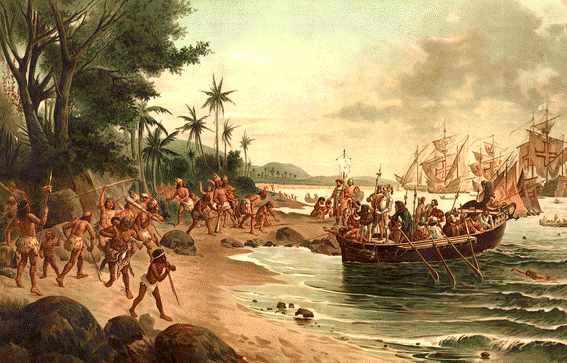ADVERTS
O Descobrimento do Brasil: Uma Análise Histórica Aprofundada
O Marco Histórico
Em 22 de abril de 1500, a história do continente americano ganhou um novo capítulo quando a esquadra portuguesa, comandada por Pedro Álvares Cabral, avistou o que viria a ser o território brasileiro. A frota, composta por 10 naus e 3 caravelas, havia partido de Portugal 44 dias antes, inaugurando assim uma nova era nas relações entre Europa e América do Sul.

A Sequência dos Acontecimentos
Os primeiros dias após o avistamento foram marcados por eventos significativos:
ADVERTS
- 22 de abril: Avistamento do Monte Pascoal
- 23 de abril: Primeiro desembarque em solo brasileiro
- 26 de abril: Celebração da primeira missa, conduzida por Frei Henrique de Coimbra
- 1º de maio: Segunda missa e oficialização da posse da terra com a instalação da cruz com o brasão real
- 2 de maio: Partida da esquadra em direção às Índias
A Questão da Intencionalidade
Evidências de um Planejamento Prévio
A descoberta do Brasil não foi um mero acaso, como comprovam diversos fatores históricos:
- Conhecimento Náutico Português
- Domínio das correntes marítimas do Atlântico Sul
- Experiência com a Corrente das Canárias
- Familiaridade com a Corrente de Benguela
- Conhecimento estratégico da Corrente do Brasil
- Contexto Histórico
- Descoberta da América por Colombo em 1492
- Assinatura do Tratado de Tordesilhas em 1494
- Expedições espanholas anteriores na costa do atual Nordeste
- Viagem secreta de Duarte Pacheco Pereira
- Estratégias Políticas
- Omissão intencional do brasão real de pedra nas caravelas
- Participação de Duarte Pacheco Pereira na expedição
- Planejamento diplomático prévio
O Contexto da Expansão Marítima Portuguesa
Bases do Empreendimento Marítimo
Portugal desenvolveu uma estrutura complexa que possibilitou suas navegações:
- Apoio Institucional
- Suporte da burguesia mercantil
- Participação ativa da nobreza cruzadista
- Investimento estatal significativo
- Desenvolvimento Tecnológico
- Escola de Sagres sob comando do Infante Dom Henrique
- Avanços na construção naval
- Aperfeiçoamento de instrumentos de navegação
- Objetivos Comerciais
- Busca por rotas para as Índias
- Interesse em especiarias orientais
- Comércio de ouro e marfim africano
- Tráfico de escravos
A Navegação e suas Particularidades
Aspectos Técnicos da Viagem
A expedição de Cabral beneficiou-se do conhecimento acumulado pelos portugueses:
- Correntes Marítimas
- Utilização estratégica da Corrente das Canárias
- Aproveitamento da Corrente do Brasil
- Navegação calculada pelo Atlântico Sul
- Rotas Estabelecidas
- Desvio intencional da costa africana
- Utilização de ventos favoráveis
- Planejamento das etapas da viagem
O Impacto Global do Descobrimento
Consequências Históricas
ADVERTS
O descobrimento do Brasil se insere em um contexto mais amplo:
- Expansão do Capitalismo Comercial
- Abertura de novas rotas comerciais
- Estabelecimento de novos mercados
- Desenvolvimento de redes mercantis
- Disputas Territoriais
- Competição entre potências europeias
- Definição de fronteiras coloniais
- Estabelecimento de áreas de influência
- Transformações Culturais
- Encontro entre civilizações
- Intercâmbio de conhecimentos
- Miscigenação cultural
O Legado do Descobrimento
Impactos Duradouros
O descobrimento do Brasil deixou marcas profundas que perduram até hoje:
- Formação Nacional
- Estabelecimento das bases territoriais
- Desenvolvimento de uma identidade própria
- Influência na estrutura social brasileira
- Herança Cultural
- Língua portuguesa como idioma oficial
- Influência religiosa católica
- Tradições e costumes portugueses
- Relações Internacionais
- Laços históricos com Portugal
- Posição geopolítica estratégica
- Integração com o mundo lusófono
Conclusion
O descobrimento do Brasil representa mais que um simples evento histórico – foi um momento decisivo que alterou o curso da história tanto para Portugal quanto para o continente americano. A intencionalidade do descobrimento, comprovada por evidências históricas e pelo contexto da época, demonstra o planejamento estratégico português em sua expansão marítima e comercial.
Este evento marca o início de um processo complexo de colonização que moldou profundamente a formação do Brasil, estabelecendo bases culturais, sociais e econômicas que influenciam o país até os dias atuais. A compreensão deste momento histórico é fundamental para entender não apenas o passado brasileiro, mas também seu presente e as perspectivas para seu futuro.
